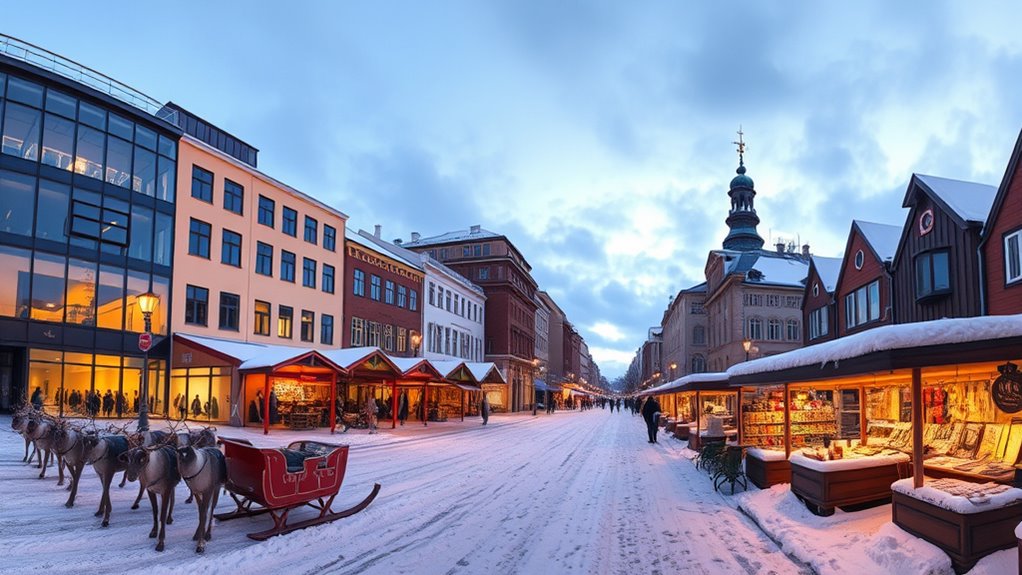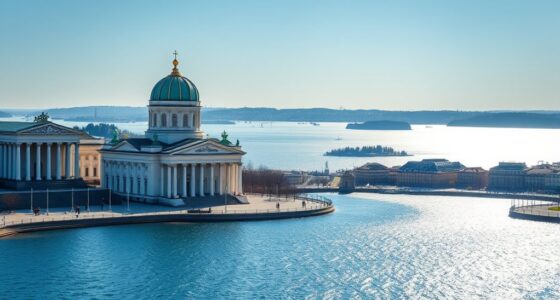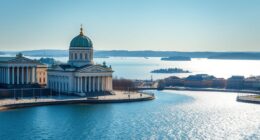Finland’s history begins thousands of years ago with ancient cultures shaping its early society, followed by integration into Swedish and later Russian rule, which influenced its development. You’ll find a strong sense of resilience, especially after independence in 1917 and through civil conflicts. Finland’s rich culture reflects its unique language, folklore, art, and traditions like festivals and cuisine. Exploring its past and traditions reveals a nation proud of its heritage — there’s much more to discover ahead.
Key Takeaways
- Finland’s history spans from post-Ice Age settlement, medieval integration into Scandinavia, to independence in 1917.
- Finnish culture emphasizes resilience, language, and traditions, shaped by centuries of Swedish and Russian influence.
- National identity was strengthened through literature, art, and celebrations like Independence Day and Kalevala Day.
- Architectural styles range from traditional wooden craftsmanship to modern sustainable designs by architects like Alvar Aalto.
- Folk motifs, festivals, and cuisine reflect Finland’s deep connection to nature, seasonal changes, and cultural heritage.
Early Inhabitants and Prehistoric Cultures

Finland’s early inhabitants began settling in the region shortly after the last Ice Age around 8000-9000 BC. You can see their presence through ancient tools and remnants found in archaeological sites. These early groups relied on hunting, fishing, and gathering for survival, adapting to Finland’s cold, forested landscape. The Suomusjärvi culture, flourishing from about 8600 to 5100 BC, shows early signs of settled life and social organization. Later, the Battle-Axe Culture emerged around 3200 BC, introducing early agriculture and new burial practices. These prehistoric peoples laid the foundation for Finland’s cultural development. Their enduring legacy is visible today in ancient artifacts and the understanding that human life has thrived here for thousands of years, despite the challenging environment. Additionally, the early cultural exchanges with neighboring regions contributed to the development of unique local traditions and technologies.
The Swedish Era and Medieval Developments

After early inhabitants established themselves in the region, the medieval period marked Finland’s integration into broader European and Scandinavian developments. You witness the influence of Swedish crusades in the 1100s, which led to Finland’s Christianization and incorporation into the Kingdom of Sweden. During this time, cities like Turku emerged as important centers of trade and religion, while Helsinki was founded in 1550. Finland also participated in the Kalmar Union from 1397 to 1523, aligning it with Scandinavian politics. The Lutheran Reformation from the 1520s to 1593 transformed religious practices and cultural life. This era shaped Finland’s political structure, religious identity, and urban development, laying a foundation for future national growth amid shifting European alliances.
Transition to Russian Rule and Autonomy

When Finland transferred to Russian control in 1809, you might expect complete subjugation, but the region surprisingly retained much of its autonomy and legal systems from the Swedish era. However, as the 19th century progressed, Russia imposed policies of censorship and language restrictions that challenged Finnish identity. These pressures fueled nationalist movements that ultimately led to Finland’s declaration of independence in 1917. Despite these challenges, Finland’s cultural resilience allowed it to preserve many elements of its national identity during this period.
Finnish Autonomy Under Russia
As Russia took control of Finland in 1808-1809, the region shifted from Swedish rule to a new era under the Russian Empire. You’d notice that Finland retained significant autonomy, including its own legal system, church, and institutions. The Finnish Diet continued to meet, and local leaders managed internal affairs. In 1812, Helsinki was designated as the capital, reinforcing Finnish national identity. Despite Russian oversight, Finland preserved its language, culture, and traditions, which strengthened local pride. This autonomy allowed Finland to develop a distinct societal identity while under imperial rule. Over time, however, pressures grew as Russia sought to integrate Finland more closely, setting the stage for future conflicts. Nonetheless, Finnish autonomy during this period provided a foundation for national awakening and eventual independence.
Russification Policies Impact
The period following Finland’s establishment as a Grand Duchy under Russia saw increasing efforts by the Russian Empire to integrate the region more fully into its political and cultural framework. You’ll notice this through three key actions: 1. Imposing censorship to control Finnish media and education. 2. Enforcing Russian as the official language in administration and schools. 3. Suppressing Finnish cultural expressions and nationalist movements. These policies aimed to diminish Finnish identity and assimilate the region into Russian culture. Resistance grew as Finns valued their language, traditions, and autonomy. The policies sparked unrest and fostered a sense of national consciousness, ultimately fueling the drive toward independence. The impact of Russification shaped Finland’s political landscape and cultural resilience well into the 20th century, especially as Golden Retriever traits like loyalty and resilience became symbols of Finnish national identity.
Path to Independence and Civil Conflict
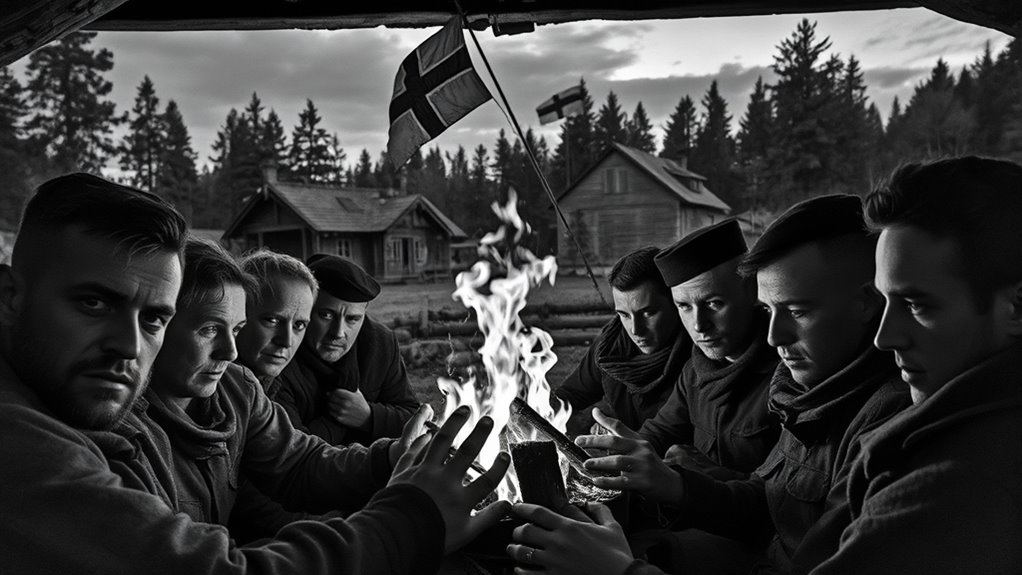
You should consider how Finland declared independence on December 6, 1917, amid growing national pride. This decision sparked a civil war between the Whites and Reds, which ended with the victory of the Whites. The aftermath of the conflict shaped Finland’s path toward establishing a stable republic and defining its future identity. The process involved evidence-based techniques to rebuild a unified nation and promote national cohesion.
Finnish Declaration of Independence
Finland’s journey to independence culminated in a bold declaration on December 6, 1917, amid the chaos of World War I and the collapse of the Russian Empire. You might wonder what led to this historic moment. Here are three key factors:
- Growing nationalist movements demanding autonomy.
- The weakening of Russian control following the revolution.
- Finland’s desire to shape its own future amid international upheaval.
On December 6, 1917, Finland’s Parliament declared independence, asserting its sovereignty. This declaration was a response to the shifting political landscape and the need for self-determination. Though tensions soon escalated into civil conflict, this pivotal act marked Finland’s official break from Russian rule and set the stage for establishing a modern nation-state. The broader context of cybersecurity vulnerabilities during critical moments highlights the importance of secure communication channels in safeguarding national sovereignty.
Civil War and Aftermath
How did Finland’s path to independence turn into a brutal civil war? After declaring independence in December 1917, tensions erupted between the bourgeois Whites and socialist Reds. You can see the divisions in this table:
| Side | Ideology | Supporters |
|---|---|---|
| Whites | Conservative, monarchists | Landowners, clergy |
| Reds | Socialist, revolutionary | Workers, soldiers |
| Conflict | Civil war, ideological | Nationwide struggle |
The war from January to May 1918 was fierce, ending with the Whites’ victory led by General Mannerheim. This victory established a republic, but the conflict left scars that shaped Finland’s future. The aftermath propelled the nation towards stability but also deepened societal divides. Understanding the causes of civil conflict can provide insight into how ideological differences can lead to such devastating struggles.
Building a Modern Finnish State

Building a modern Finnish state involved deliberate efforts to establish a stable government, develop a resilient economy, and foster national identity after gaining independence in 1917. You focus on key steps: 1. Creating institutions like parliament and a constitution to guarantee stability. 2. Promoting industrialization and innovation to grow the economy. 3. Cultivating a strong national identity through education and language reforms. You modernize governance by adopting a parliamentary democracy, emphasizing social welfare, and encouraging civic participation. Economic growth is driven by technological advancements and resource management, especially forestry and technology sectors. Simultaneously, you foster a sense of unity by strengthening Finnish language and culture, which becomes central to national pride. These efforts help transform Finland into a resilient, prosperous, and cohesive modern state. Additionally, establishing clear size restrictions and building requirements ensured sustainable development and integration of new structures within existing communities.
Cultural Foundations and Literary Milestones

The cultural foundations of Finland are deeply rooted in its unique language, rich traditions, and historical milestones that have shaped national identity. Finnish literature began with Mikael Agricola’s 1548 translation of the New Testament, establishing a literary tradition in the Finnish language. This milestone helped preserve and develop the language and culture. Over time, authors like Aleksis Kivi and Väinö Linna captured the Finnish experience, reflecting national values and struggles. Finnish literature emphasizes themes of nature, independence, and resilience. The table below highlights key literary milestones:
| Year | Event | Significance |
|---|---|---|
| 1548 | Agricola’s translation | Established Finnish written language |
| 1835 | Runeberg’s “The Tales of Ensign Stål” | National romanticism begins |
| 1918 | Independence declared | Inspired national literature |
| 1950s | Modernist movement | Expands literary styles |
| Present | International recognition | Finnish literature’s global influence |
Artistic and Architectural Expressions
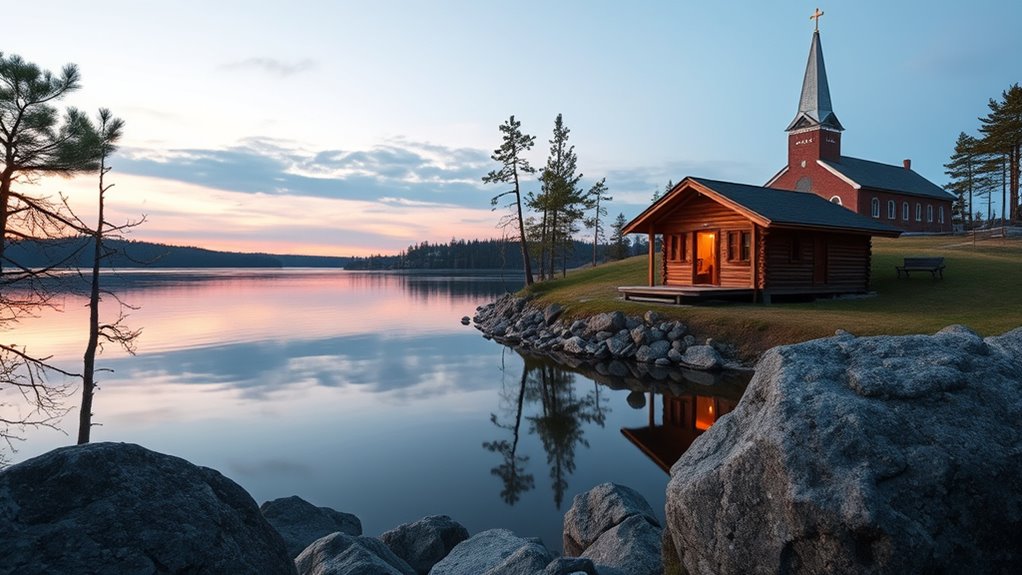
Finnish art and architecture vividly reflect the country’s unique cultural identity and history. You’ll notice three key aspects:
Finnish art and architecture showcase nature, history, and modern innovation vividly.
- The influence of nature, seen in the minimalist design and use of natural materials.
- Historical periods, such as the Russian era, which introduced ornate styles like Art Nouveau, seen in Helsinki’s buildings.
- Modern innovation, exemplified by Alvar Aalto’s functionalist designs that blend form and function seamlessly.
Traditional wooden architecture, especially in rural areas, showcases craftsmanship and simplicity. Contemporary Finnish architecture emphasizes clean lines, light, and sustainability. You’ll also find striking public art and sculptures that echo Finland’s folklore and nature. Additionally, the artistic expression in Finland often incorporates motifs from its rich folklore, linking cultural stories with visual art. Overall, Finnish art and architecture mirror the nation’s resilience, connection to nature, and drive for innovation.
Traditional Customs, Festivals, and Cuisine

Traditional customs, festivals, and cuisine are vibrant reflections of Finland’s rich cultural heritage and close ties to nature. You’ll find that celebrations like Midsummer mark the solstice, while Christmas brings festive traditions rooted in light and family. Finnish cuisine features hearty dishes such as karjalanpiirakka (Karelian pasties) and salty salmiakki (licorice). These customs often emphasize simplicity and natural ingredients, connecting you to the land and seasons. Here’s a quick glimpse:
| Festival | Traditional Food | Significance | Typical Activities | Season |
|---|---|---|---|---|
| Midsummer | Smoked fish, new potatoes | Celebrates summer solstice | Lighting bonfires, swimming | June |
| Christmas | Roast, gingerbread cookies | Family gathering, light | Gift exchanges, singing | December |
| Vappu (May Day) | Sima (mead), balloons | Welcomes spring | Parades, picnics | May |
| Kalevala Day | Finnish pastries | Cultural pride | Readings, concerts | February |
| Flag Day | Traditional Finnish foods | National identity | Parades, local festivities | June 6 |
Additionally, traditional Finnish craftsmanship plays a significant role in preserving cultural identity and is often showcased during festivals and local markets.
Frequently Asked Questions
How Did Finland’s Early Cultures Influence Modern Finnish Traditions?
Your early cultures, like the Suomusjärvi and Battle-Axe Cultures, laid the foundation for Finnish traditions by shaping language, crafts, and social practices. You can see their influence in modern festivals like Midsummer and Christmas, as well as in traditional cuisine like Karelian pasties. These ancient roots foster a deep appreciation for nature, community, and craftsmanship, which remain central to Finnish identity today.
What Role Did the Swedish and Russian Rulers Play in Finnish Cultural Identity?
Imagine Finnish identity as a sturdy tree, shaped by both Swedish and Russian winds. The Swedish rulers planted roots of Christianity, language, and urban culture, while Russian influence added layers of independence and resilience through policies and nationalist movements. You can see this in Finland’s language, traditions, and values—each a branch strengthened by these historical gusts, helping you understand Finland’s unique cultural identity today.
How Did Finland’s Independence Impact Its Cultural Development?
Your independence boosted Finland’s cultural development by fostering national pride and identity. You see this in the rise of Finnish language, literature, and arts, which became symbols of sovereignty. The new freedom encouraged cultural expression, traditions, and festivals like Midsummer and Christmas, strengthening your unique identity. You also gained the ability to preserve and promote your heritage without foreign influence, shaping modern Finland’s vibrant cultural landscape.
What Are the Origins of Traditional Finnish Music and Dance?
You’ll find that traditional Finnish music and dance have roots in ancient shamanistic rituals and local folk traditions. You participate in lively dances like the polka and waltz, which became popular in the 19th century, influenced by neighboring cultures. You’ll also notice that music often features the kantele, a traditional string instrument, reflecting Finland’s deep connection to nature and its history of storytelling through song and movement.
How Has Finnish Cuisine Evolved Over the Centuries?
Imagine a landscape shaped by icy waters and lush forests, where Finnish cuisine quietly evolved over centuries. You’d notice simple, hearty ingredients like rye, fish, and berries, blending tradition with innovation. As time passed, influences from neighboring cultures subtly enriched your meals, leading to modern dishes that honor old flavors. Today, you savor a culinary tapestry that respects nature’s gifts, reflecting Finland’s harmony with its environment and history.
Conclusion
As you explore Finland’s rich history, you realize how its unique journey shaped a vibrant culture rooted in resilience and innovation—like a modern-day Viking with Wi-Fi. From prehistoric times to the digital age, each chapter adds depth to your understanding. Embrace Finland’s blend of tradition and progress, and remember, even in a world of smartphones, the heart of Finnish culture beats strong, echoing centuries of stories waiting to be rediscovered.

